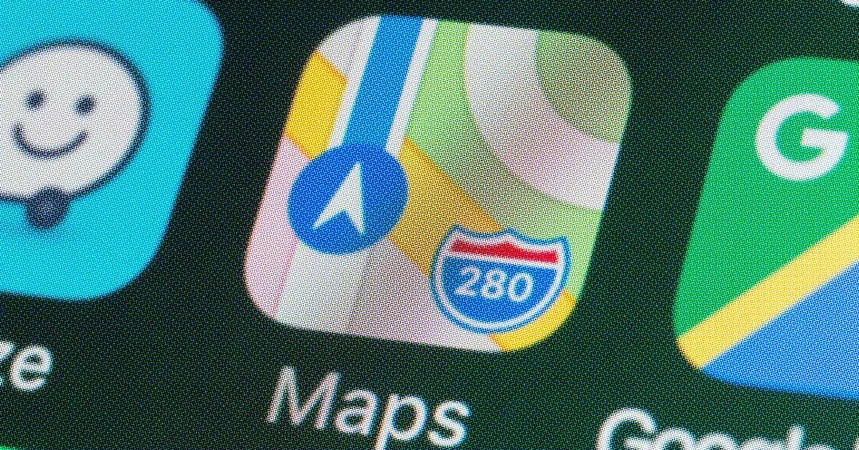
Discover Why Apple Maps Surpasses Google Maps in These 4 Key Areas
2025-01-21
Author: Jia
When Apple Maps was launched in 2012, it was met with a spectacularly rocky start, famously directing drivers to navigate into rivers! Many wrote it off as a failed experiment, an opinion that lingered for years due to its lack of reliability. However, fast forward over a decade, and Apple's mapping solution has undergone significant improvements, emerging as a strong competitor to Google Maps.
As a tech enthusiast who frequently alternates between both navigation apps, I've found that Apple Maps now offers a comparable level of reliability for turn-by-turn directions. While Google Maps tends to have a more extensive database of businesses, especially new ones, typing the same address into either app generally yields similarly effective navigation results. But hold your horses—Apple Maps does boast some features that eclipse Google Maps! Here’s a look at four standout aspects:
1. Crystal Clear Navigation Instructions
One of the most notable enhancements in Apple Maps is its user-friendly audio prompts. Apple maps excels at offering instructions in straightforward language. For instance, while Google directs you to "turn left in 200 feet," Apple might say, "turn left at the next traffic light." This nuance makes a significant difference in navigating without confusion, feeling more like having a personal navigator alongside you.
Additionally, many users find Apple's navigation voices more pleasant and articulate, further enhancing the overall experience.
2. Instant Transit Information at Your Fingertips
Apple Maps includes a nifty feature called "Nearby Transit," presenting a real-time list of upcoming buses and trains at your current location. This feature is incredibly useful when you're making plans or just deciding when to leave a restaurant or bar, as it grants you immediate access to several transit options at once.
Google Maps, while offering transit directions and arrival times for specific stations, doesn’t provide a quick overview of multiple nearby options. This is a clear advantage that could inspire Google to revamp its transit features!
3. Seamless Integration with Apple Devices
Apple Maps is intricately woven into the Apple ecosystem, and this integration is a game-changer. The ability to create shortcuts, like a one-tap option to save your parking spot directly from your homepage, is a fantastic feature that Google Maps doesn't support on iOS devices. Moreover, Apple Maps is the default when accessing directions from other Apple applications, ensuring a cohesive user experience across your devices.
This built-in functionality extends to Siri as well, making interactions smoother and more intuitive, especially for Apple ecosystem users.
4. A Cleaner, More Intuitive Interface
If you launch both apps side by side, you’ll quickly notice the visual disparity. Apple Maps presents a clean interface with minimal distractions, showing fewer icons and toolbars that clutter the screen. The map's layout emphasizes useful geographic information rather than promotional ads, creating a more enjoyable user experience.
Sure, opinions on design are subjective, but many users appreciate how Apple's design choices prioritize ease of use when navigating.
Conclusion: Apple Maps Has Come a Long Way!
It’s essential to acknowledge that Google Maps does have advantages, particularly in the vast amount of business data it provides. While Apple Maps is catching up, especially after my own recent experience in Peru where Apple Maps fell short, the improvements over the years are undeniable.
If you haven’t explored Apple Maps lately, it’s time to give it another shot—you might discover features that will surprise you. The evolution of Apple Maps is a testament to how software can transform, making navigation easier, clearer, and more integrated than ever!



 Brasil (PT)
Brasil (PT)
 Canada (EN)
Canada (EN)
 Chile (ES)
Chile (ES)
 Česko (CS)
Česko (CS)
 대한민국 (KO)
대한민국 (KO)
 España (ES)
España (ES)
 France (FR)
France (FR)
 Hong Kong (EN)
Hong Kong (EN)
 Italia (IT)
Italia (IT)
 日本 (JA)
日本 (JA)
 Magyarország (HU)
Magyarország (HU)
 Norge (NO)
Norge (NO)
 Polska (PL)
Polska (PL)
 Schweiz (DE)
Schweiz (DE)
 Singapore (EN)
Singapore (EN)
 Sverige (SV)
Sverige (SV)
 Suomi (FI)
Suomi (FI)
 Türkiye (TR)
Türkiye (TR)
 الإمارات العربية المتحدة (AR)
الإمارات العربية المتحدة (AR)